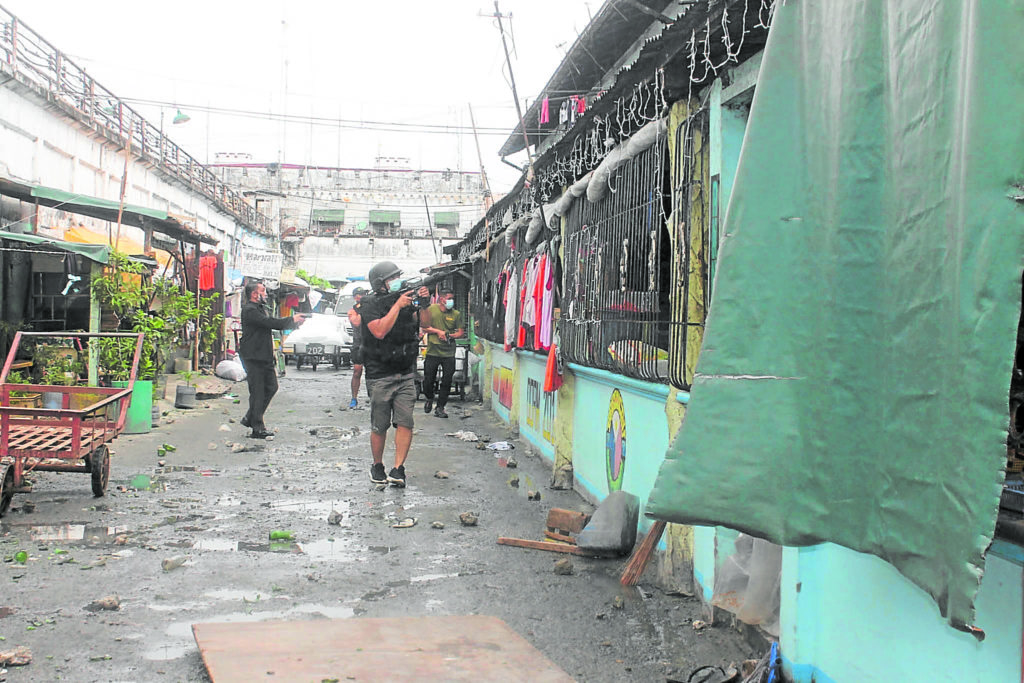
MAXIMUM SECURITY CONCERN Commandos swoop down on New Bilibid Prison’s maximum security compound in Muntinlupa City to break up Monday morning’s riot between two rival gangs that left three inmates dead and more than 60 others injured. —PHOTO FROM BUCOR PIO
MANILA, Philippines — A truce between warring gangs in New Bilibid Prison at Muntinlupa City failed on Monday, resulting in fresh violence that left at least three inmates dead and 64 others injured.
The Bureau of Corrections (BuCor) said a free-for-all broke out at the national penitentiary’s maximum security compound at 8:39 a.m. after a member of the Sigue Sigue Commando gang was stabbed by another inmate.
“It started just with small groups, who retaliated [against each other when attacked]. Then the violence grew,” BuCor spokesperson Gabriel Chaclag said.
Police called in
Chaclag said Special Weapons and Tactics officers were deployed to quell the violence, but they were met with gunfire, forcing the bureau to call the police for backup.
Officers from the Philippine National Police Special Action Force, National Capital Region Police Office and the Bureau of Fire Protection arrived to help the BuCor security force break up the riot.
The BuCor said the riot was contained at about 10 a.m. but clearing operations only ended just before evening.
Chaclag did not identify the other gang involved, but Bilibid sources said it was the Sigue Sigue Sputnik, which clashed with the Sigue Sigue Commando at Bilibid’s Quadrant 4 on Oct. 9. Nine inmates were killed in that riot and seven were injured.
The BuCor had yet to identify the dead in Monday’s riot, all Sputnik gang members. Chaclag said six wounded inmates were being treated at Ospital ng Muntinlupa.
In a press statement, the BuCor said it would discipline the inmates responsible for the outbreak of violence.
It said bureau personnel who were in their offices at the height of the riot were evacuated.
The bureau, however, had no answer when asked how the inmates got hold of firearms. “It will be part of the investigation,” Chaclag said.
He said Bilibid and six other prison farms and penal colonies in the country were placed on the highest alert to “ensure peace and order” after the second deadly clash between rival gangs in the national penitentiary.
NBI probe ordered
Justice Secretary Menardo Guevarra ordered the National Bureau of Investigation to investigate Monday’s riot at Bilibid.
Guevarra said the Department of Justice (DOJ), which oversees the BuCor, would also look into the possible liability of Bilibid and BuCor officials for their failure to prevent riots in the national penitentiary.
“These BuCor officials should have learned their lesson from the previous violent incident where several [prisoners] were killed,” Guevarra said in a Viber message.
“The DOJ has ordered the BuCor to submit a detailed report [immediately]. I will direct the NBI to conduct a parallel investigation or expand its ongoing probe into the previous violence,” he said.
The department also directed the NBI to bring charges against all people involved and found responsible for the riot.
The Commission on Human Rights (CHR) sent a team to look into the causes of the violence.
CHR spokesperson Jacqueline Ann de Guia urged the authorities to determine the cause of the riot and adopt ways of resolving conflict among inmates to prevent violence from erupting again.
Peace measures failed
Measures the BuCor put in place after the Oct. 9 riot failed to prevent another clash between rival gangs in Bilibid, which can hold 6,435 prisoners but houses nearly 29,000.
On Oct. 13, four days after the first riot, Director General Gerald Bantag, the BuCor chief, brokered a truce between the Sigue Sigue Sputnik and Sigue Sigue Commando gangs.
Leaders of the two groups, Bantag said, “gave assurance that the brawl would never happen again.”
On Oct. 28, the BuCor brought in tattoo artists to remove the markings on 217 prisoners—120 at Bilibid, 60 at the Correctional Institution for Women in Mandaluyong City, and 37 at San Ramon Prison and Penal Farm in Zamboanga City.
Bantag said the removal of the tattoos would prevent rival gang members from identifying each other.
RED ALERT Commandos secure an inmate after another riot broke out between two warring gangs at New Bilibid Prison’s maximum security compound on Monday morning. —PHOTO FROM BUCOR PIO
There are 12 gangs in Bilibid, the biggest of which are the Sigue Sigue Sputnik, with 4,474 members; Genuine Ilocano (2,887), and Batang City Jail (2,326).
According to BuCor records, 2,307 inmates at the maximum security compound are “querna,” or unaffiliated with any gang.
Gang culture
Studies have found that the gang culture at Bilibid is the result of the government’s inability to provide vital services to inmates.
Gangs are seen as important social structures in prisons, as they provide protection, financial support and a semblance of family among members.
The informal system of self-government among gangs, a vestige of the American colonial era, has also proved integral to peacekeeping in overcrowded and understaffed prisons.
In December 2018, under Bantag’s predecessor Nicanor Faeldon, the BuCor brokered a peace pact among 12 gangs, including Sputnik and Commando. The agreement signed by the gang leaders included abolition of the gangs.
That pact, however, failed to prevent the Oct. 9 riot. The measures taken by Bantag also failed to prevent Monday’s violence. —WITH A REPORT FROM MARLON RAMOS INQ